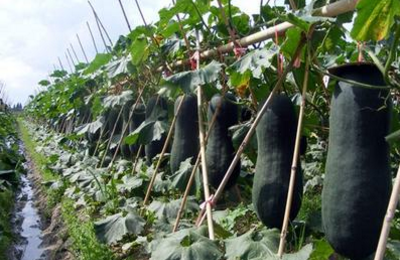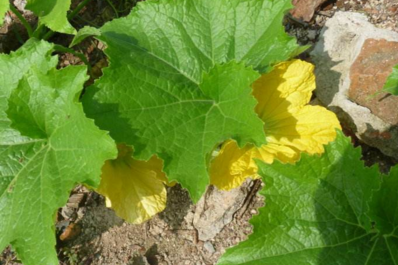In recent years, the demand for winter melon has increased. Spring-growing winter melon is rich in nutrients and high in yield. The yield of some varieties is up to 10,000 kg, and the economic benefit is good. The technical points of spring planting melon cultivation are introduced as follows. (1) Biological characteristics The whole growth period of winter melon is 140-200 days, and the flowering result period usually takes 50-70 days. Winter melon is a warm and heat-resistant vegetable with a suitable temperature of 20-30 degrees Celsius. The growth temperature during the pumping and flowering period is 25 degrees Celsius. Winter melon needs more water, is not resistant to early, and requires sufficient water supply during the growth period. Winter melon requires the most nitrogen during the whole growth period, followed by potassium and slightly less phosphorus. For every 5000 kilograms of winter melon, nitrogen needs 30-36 kg, potassium 24-30 kg, and phosphorus 24-26 kg. The main varieties of spring species are: (a) Big green skin. The weight of a single fruit is 15 - 20 kg, and the yield per mu is 3000 - 4500 kg; (b) Hunan Houji Chongdong melon. The weight of a single fruit is 40 - 50 kg, and the yield per mu is 5000 - 10000 kg; (c) Jufeng No. 1. The weight of a single fruit is 40 - 50 kg, and the yield per mu is about 6,000 - 10,000 kg; (d) Black melon. The single fruit weighs about 13 - 15 kg, and the yield per mu is 3000 - 3500 kg; (e) Dongguan black melon. The single fruit weighs about 10 - 15 kg, and the yield per mu is about 3,000 - 3,500 kg; (f) early maturity. The fruit weight is 13 - 20 kg and the yield per mu is more than 5,000 kg. (2) Cultivation techniques 1 Selection of winter melon should be cultivated on sandy loam or clay loam with deep soil layer, loose soil, good drainage, strong water retention and fertility, and should be avoided as a melon crop in the past. Crops are planted on the field to reduce the occurrence of disease. 2 sowing (a) Select the sowing time. Spring squash should be planted in the second half of January to the beginning of February, which can bring both morning and high yields. (b) Soaking seeds and germination. Immerse the melon seeds in warm water at 55 degrees Celsius, maintain a stable temperature for 15 minutes, then let them cool to about 30 degrees Celsius, continue to soak for 10-12 minutes, wash the seeds after soaking, and then mix the seeds with wet sand. Germinate at a temperature of about 30 degrees Celsius. When the seeds are white and the buds grow to 0.3-0.8 cm, they can be sown. Note that during the germination process, the seeds should be frequently turned and kept moist to facilitate the germination. (C) Sowing. Winter melon planting - the seedling transplanting method is adopted. When the nutrient soil is configured, it should be disinfected. Each 1000 kg of nutrient soil is sprayed with 50% carbendazim WP 25-30 g dissolved in water. After spraying, mix the nutrient soil. Cover it with film for 2-3 days and use it. (3) Colonization 1 The whole land is planted with a width of 2 meters, a width of 0.4 meters, and a height of 0.5 meters. Apply organic fertilizer to the central ditch. 50 kilograms of calcium phosphate or peanut bran, 1000 kilograms of soil per mu, 1000 kilograms of superphosphate or 20 kilograms of compound fertilizer. 2 Planting Planting is carried out in a single row, planted in the center of the noodle, with a plant spacing of 80-100 cm. (4) Field management 1 Choosing the cultivation method The melon cultivation method includes three kinds of winter melon, shed winter melon and winter melon. In combination with the actual situation, the shed canola cultivation method is generally adopted, and the height of the shed is preferably 1.8 - 2 meters. 2 Whole vines, vines and vines The melons rely on the main vines, but the melons are strong, and the whole vines should be removed. All the side vines are removed before and after fruit setting, and some leaves are retained after fruit setting. The melons are mainly introduced into the vines in the range of their own plant spacing. After the winter melons are put on shelves, the vines should be diligently introduced to avoid vines. The large winter melon should be pressed at the same time as the vines. The soil below the stem section is dug 5-10 cm shallow trenches, and the 1.6-meter-meter stems growing in the circle are covered with fine soil. 3 Fertilizer management (a) Reasonable topdressing. When melon is topdressing, attention should be paid to the reasonable cooperation of nitrogen, phosphorus and potassium. If the plant grows vigorously, it can be chased or not chased. If the leaf color is light or yellow, it should be topdressed in time; the melon should be less topdressed in the early stage of growth, and the water and fertilizer should be controlled before and after the female flower is opened. 1 - 2 melons should be re-fertilized after fruit-bearing, applying 15-20 kg of urea and 15 kg of compound fertilizer per acre, and then topdressing once every half month until about 10 days before harvesting, the amount of top dressing can be appropriately reduced. (b) Water management. After the melon is introduced into the vine, the water needs to be large. The horse should be irrigated once. During the flowering period, the water is not watered or watered. The water needs to be the largest during the fruit expansion period. The soil should be kept moist to ensure the yield. (5) Pest control 1 Disease prevention and treatment of rickets with 70% dikesone 300 times solution, 75% chlorothalonil 800 times solution or 70% early base thiophanate 800 times liquid spray control; 58% toxic mycelium manganese zinc 300-500 for disease Double solution, 72% Plex water 800 times solution or 72% DuPont dew WP 600 - 800 times liquid spray control; powdery mildew with 20% powder rust 2000 times solution or 75% chlorothalonil 700 times solution Prevention and treatment; anthrax is treated with 70% early thiophanate 800-1000 times solution or 50% carbendazim 1500 times solution; sunburn is covered with melon leaves or other materials to reduce direct sunlight. 2 Pest control Hummer is treated with 18% insecticidal double agent 250-400 times liquid or chlorpyrifos 1000 times liquid spray; guarded melon with 90% crystal trichlorfon 800 - 1000 times liquid or 90% Bataan wettability Powder 1000 - 1500 times liquid spray control; melon 绢螟 with 40. 7 % lesburn 1000 times solution, 50% chlorpyrifos 1000 times solution or Bacillus thuringiensis preparation spray control; melon fly with 40.7 % Loesburn 1000 times liquid, 90% trichlorfon 1000 times liquid or 80% dichlorvos 1000 times liquid spray control; cockroaches are sprayed with 1500 times of dicofol or 73% of chlorpyrifos 2000 times. Vaseline Gauze,Vaseline Gauze Pads,Vaseline Coated Gauze,Sterile Vaseline Gauze Henan Anbang Medical Supplies Co., Ltd. , https://www.anbangmedical.com
